Abstract
We have characterized a series of genetically engineered chimeric human IgG3 and IgG4 anti-dansyl (DNS) antibodies with identical antibody-combining sites but different hinge region amino acid compositions to determine how the hinge region influences Fab fragment segmental flexibility, C1q binding, and complement activation. Our data support the correlation between "upper hinge" length and Fab segmental flexibility; moreover, we confirm that a hinge region is essential for C1q binding and complement activation. However, the hinge length by itself is not sufficient for complement activity in IgG molecules. We have demonstrated that the IgG4 hinge, which imparts restricted segmental flexibility, reduces the ability of IgG3 molecules to activate complement. We also find that the IgG3 hinge region, which imparts greater segmental motion, is not sufficient to create complement activation activity in IgG4 anti-DNS antibodies. Finally, we conclude that (i) segmental motion is correlated with "upper hinge" length, (ii) hinge length and segmental flexibility is not enough to alter complement binding and activation, and (iii) segmental flexibility does not correlate with proficiency to activate the complement cascade.
Full text
PDF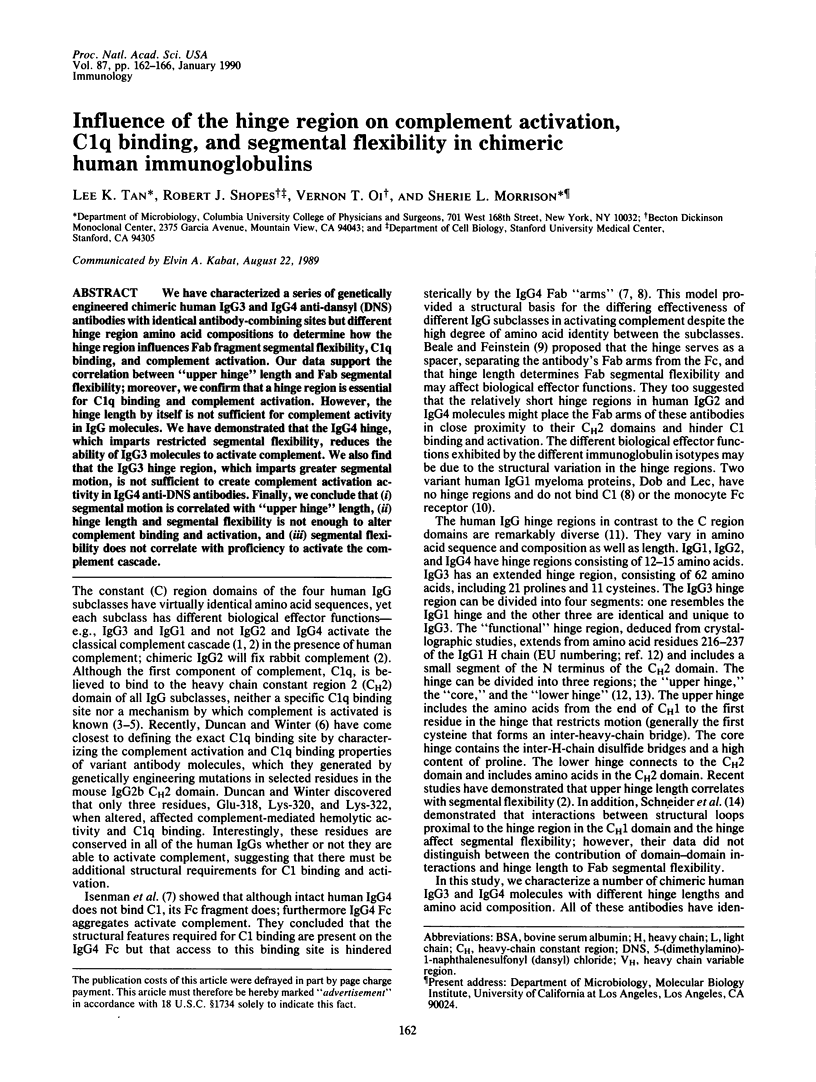
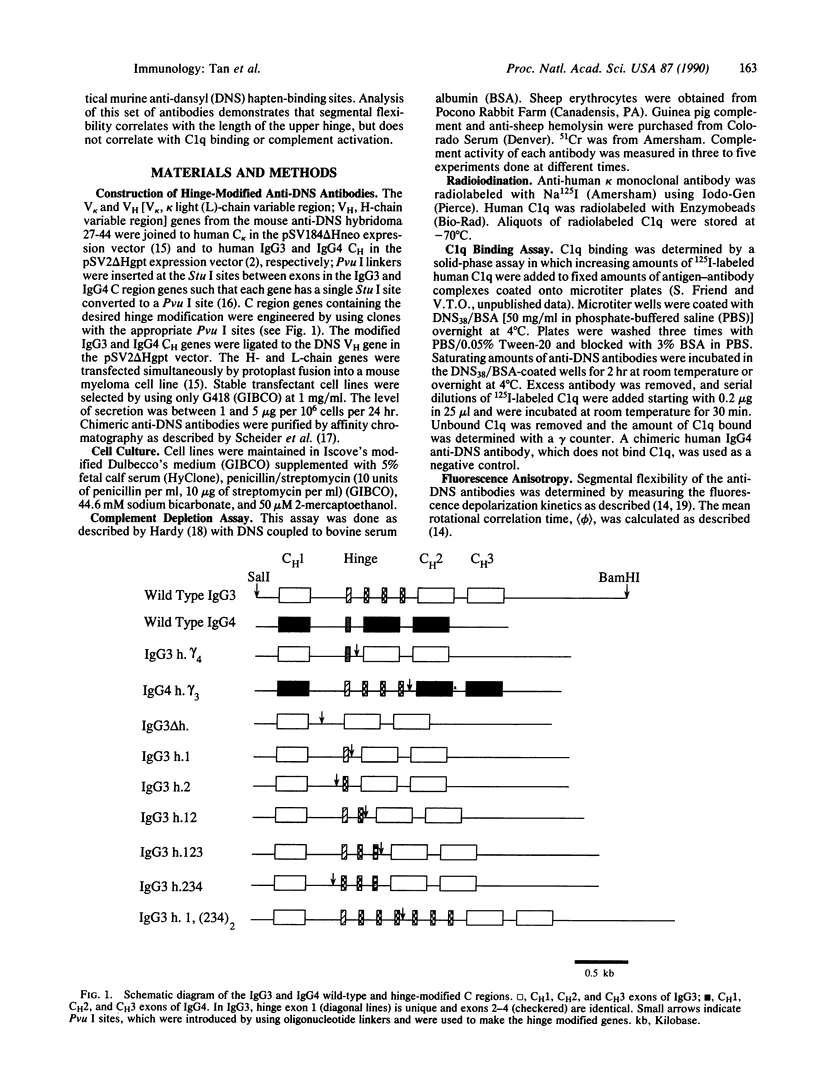
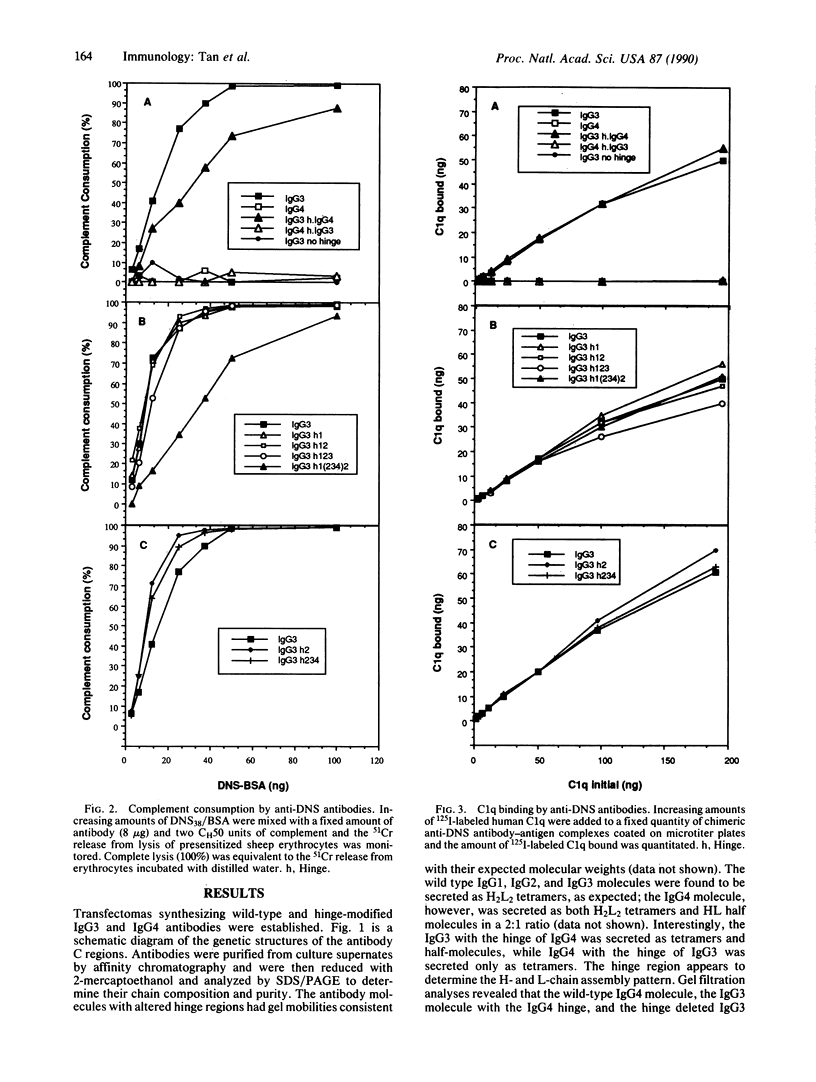
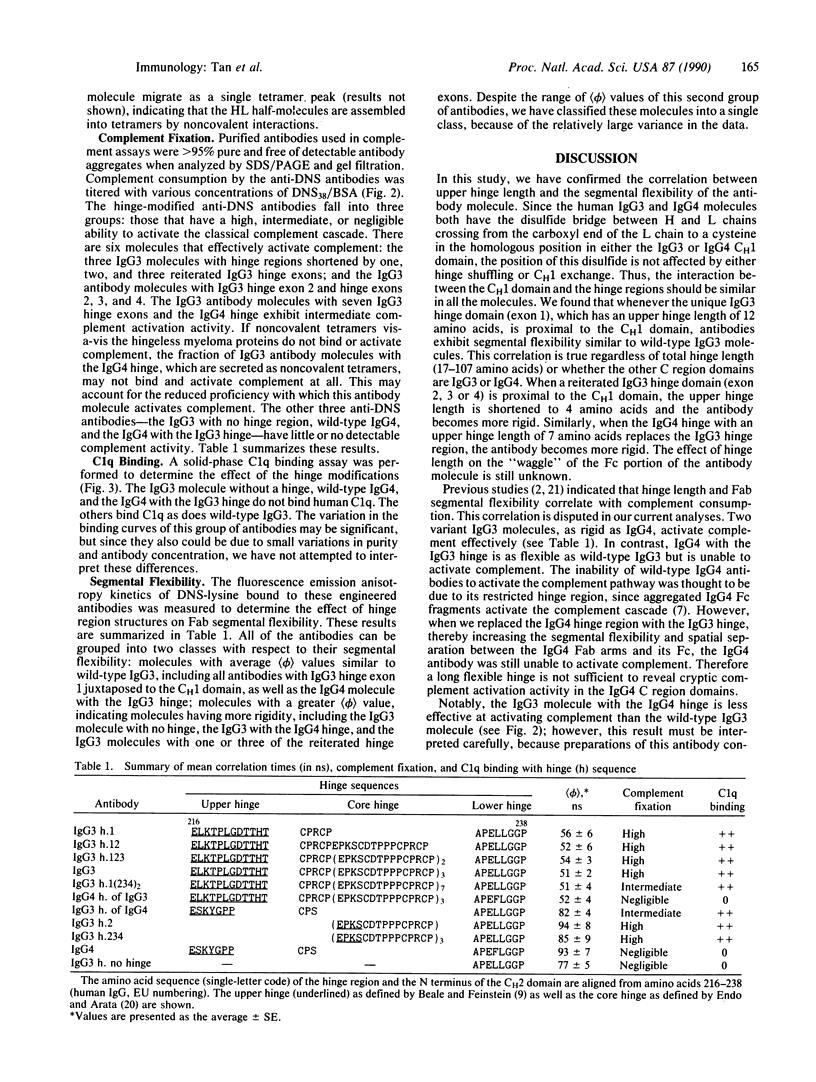
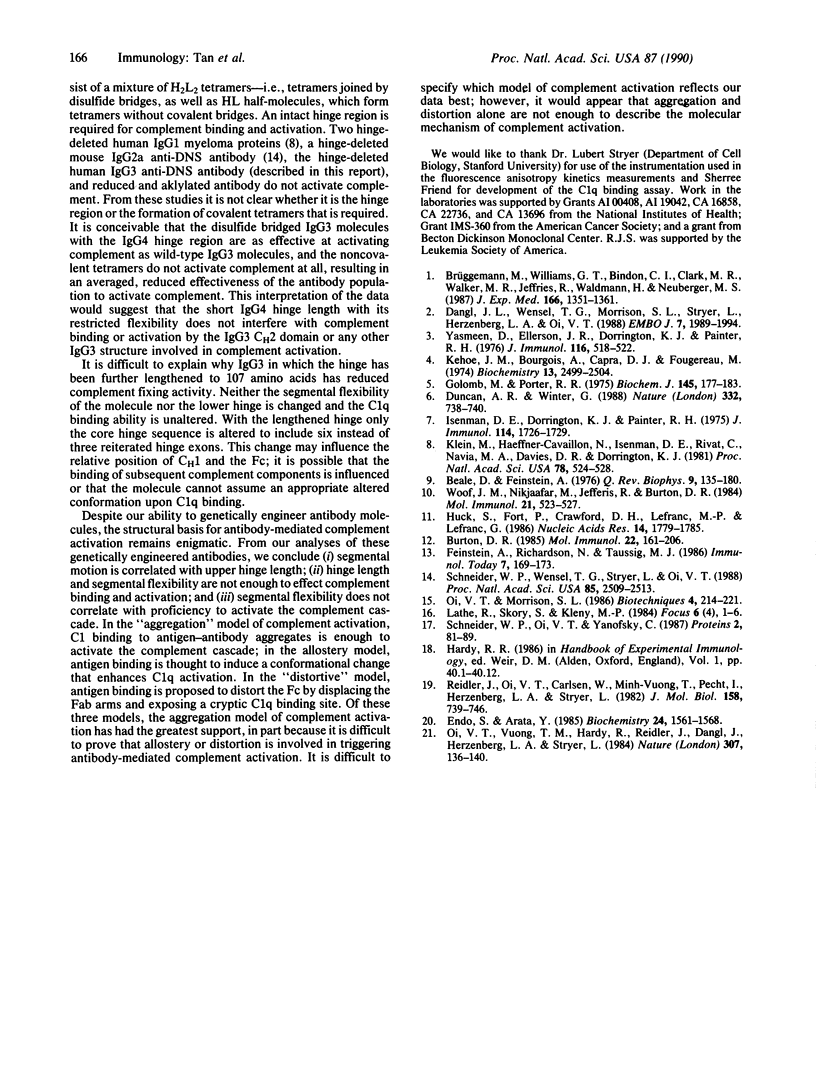
Selected References
These references are in PubMed. This may not be the complete list of references from this article.
- Beale D., Feinstein A. Structure and function of the constant regions of immunoglobulins. Q Rev Biophys. 1976 May;9(2):135–180. doi: 10.1017/s0033583500002390. [DOI] [PubMed] [Google Scholar]
- Brüggemann M., Williams G. T., Bindon C. I., Clark M. R., Walker M. R., Jefferis R., Waldmann H., Neuberger M. S. Comparison of the effector functions of human immunoglobulins using a matched set of chimeric antibodies. J Exp Med. 1987 Nov 1;166(5):1351–1361. doi: 10.1084/jem.166.5.1351. [DOI] [PMC free article] [PubMed] [Google Scholar]
- Burton D. R. Immunoglobulin G: functional sites. Mol Immunol. 1985 Mar;22(3):161–206. doi: 10.1016/0161-5890(85)90151-8. [DOI] [PubMed] [Google Scholar]
- Colomb M., Porter R. R. Characterization of a plasmin-digest fragment of rabbit immunoglobulin gamma that binds antigen and complement. Biochem J. 1975 Feb;145(2):177–183. doi: 10.1042/bj1450177. [DOI] [PMC free article] [PubMed] [Google Scholar]
- Dangl J. L., Wensel T. G., Morrison S. L., Stryer L., Herzenberg L. A., Oi V. T. Segmental flexibility and complement fixation of genetically engineered chimeric human, rabbit and mouse antibodies. EMBO J. 1988 Jul;7(7):1989–1994. doi: 10.1002/j.1460-2075.1988.tb03037.x. [DOI] [PMC free article] [PubMed] [Google Scholar]
- Duncan A. R., Winter G. The binding site for C1q on IgG. Nature. 1988 Apr 21;332(6166):738–740. doi: 10.1038/332738a0. [DOI] [PubMed] [Google Scholar]
- Huck S., Fort P., Crawford D. H., Lefranc M. P., Lefranc G. Sequence of a human immunoglobulin gamma 3 heavy chain constant region gene: comparison with the other human C gamma genes. Nucleic Acids Res. 1986 Feb 25;14(4):1779–1789. doi: 10.1093/nar/14.4.1779. [DOI] [PMC free article] [PubMed] [Google Scholar]
- Isenman D. E., Dorrington K. J., Painter R. H. The structure and function of immunoglobulin domains. II. The importance of interchain disulfide bonds and the possible role of molecular flexibility in the interaction between immunoglobulin G and complement. J Immunol. 1975 Jun;114(6):1726–1729. [PubMed] [Google Scholar]
- Kehoe J. M., Bourgois A., Capra J. D., Fougereau M. Amino acid sequence of a murine immunoglobulin fragment that possesses complement fixing activity. Biochemistry. 1974 Jun 4;13(12):2499–2504. doi: 10.1021/bi00709a005. [DOI] [PubMed] [Google Scholar]
- Klein M., Haeffner-Cavaillon N., Isenman D. E., Rivat C., Navia M. A., Davies D. R., Dorrington K. J. Expression of biological effector functions by immunoglobulin G molecules lacking the hinge region. Proc Natl Acad Sci U S A. 1981 Jan;78(1):524–528. doi: 10.1073/pnas.78.1.524. [DOI] [PMC free article] [PubMed] [Google Scholar]
- Oi V. T., Vuong T. M., Hardy R., Reidler J., Dangle J., Herzenberg L. A., Stryer L. Correlation between segmental flexibility and effector function of antibodies. Nature. 1984 Jan 12;307(5947):136–140. doi: 10.1038/307136a0. [DOI] [PubMed] [Google Scholar]
- Reidler J., Oi V. T., Carlsen W., Vuong T. M., Pecht I., Herzenberg L. A., Stryer L. Rotational dynamics of monoclonal anti-dansyl immunoglobulins. J Mol Biol. 1982 Jul 15;158(4):739–746. doi: 10.1016/0022-2836(82)90258-3. [DOI] [PubMed] [Google Scholar]
- Schneider W. P., Oi V. T., Yanofsky C. Hybrid immunoglobulin isotypes of identical specificity produced by genetic recombination in Escherichia coli and expression in lymphoid cells. Proteins. 1987;2(2):81–89. doi: 10.1002/prot.340020203. [DOI] [PubMed] [Google Scholar]
- Schneider W. P., Wensel T. G., Stryer L., Oi V. T. Genetically engineered immunoglobulins reveal structural features controlling segmental flexibility. Proc Natl Acad Sci U S A. 1988 Apr;85(8):2509–2513. doi: 10.1073/pnas.85.8.2509. [DOI] [PMC free article] [PubMed] [Google Scholar]
- Woof J. M., Nik Jaafar M. I., Jefferis R., Burton D. R. The monocyte binding domain(s) on human immunoglobulin G. Mol Immunol. 1984 Jun;21(6):523–527. doi: 10.1016/0161-5890(84)90068-3. [DOI] [PubMed] [Google Scholar]
- Yasmeen D., Ellerson J. R., Dorrington K. J., Painter R. H. The structure and function of immunoglobulin domains. IV. The distribution of some effector functions among the Cgamma2 and Cgamma3 homology regions of human immunoglobulin G1. J Immunol. 1976 Feb;116(2):518–526. [PubMed] [Google Scholar]


